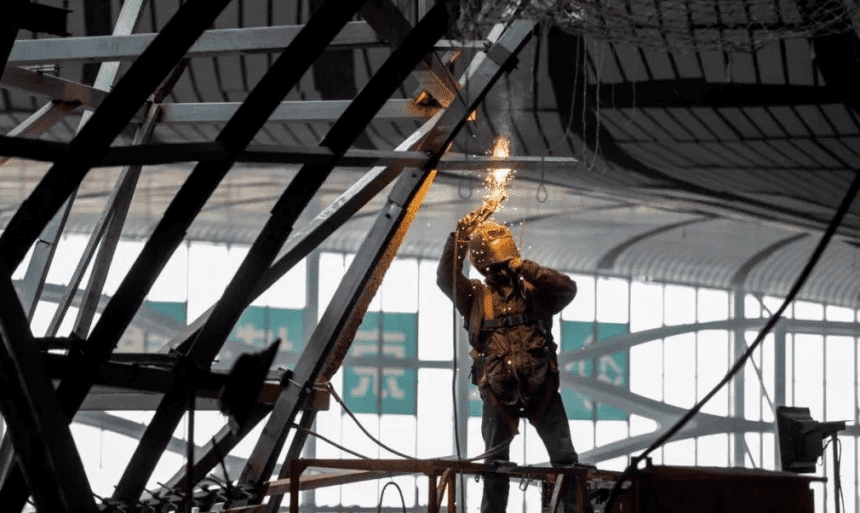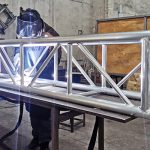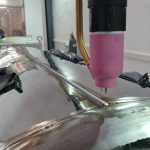Heat-resistant steel is steel that is both thermally stable and thermally strong under high-temperature conditions. Thermal stability is the ability of steel to maintain chemical stability (corrosion resistance, non-oxidation) under high-temperature conditions. Thermal strength means that the steel has sufficient strength under high-temperature conditions. The heat resistance is mainly ensured by the alloying elements such as chromium, molybdenum, vanadium, titanium, and niobium, so the choice of welding material should be determined by the alloying element content of the base material.
Heat-resistant steel in the petroleum and petrochemical industry device construction is more widely used, we can often come into contact with the lower alloy content of pearlite heat-resistant steel, such as 15CrMo, 1Cr5Mo, etc.
Wedling Town
1 Chromium and molybdenum heat-resistant steel weldability
Chromium and molybdenum are the main alloying elements of pearlite heat-resistant steel, significantly improving the metal’s high-temperature strength and high-temperature oxidation resistance, but they make the metal’s welding properties become poor, in the weld and heat-affected zone with the tendency to quench, after welding in the air cooling easy to produce hard and brittle martensite organization, not only affect the mechanical properties of the welded joint but also produce large internal stress, resulting in the tendency to cold cracking.
Therefore, the main problem when welding heat-resistant steel is cracking, and the formation of cracks in the three elements are: organization, stress, and the amount of hydrogen in the weld, so the development of a reasonable welding process is particularly important.
2 pearlite heat-resistant steel welding process
2.1 Beveling
The bevel is usually processed with a flame or plasma cutting process, if necessary, the cut should also be preheated, polished clean, and PT inspection to remove cracks on the bevel. The bevel angle is 60°. From the point of view of preventing cracks, it is advantageous to have a larger bevel angle, but it increases the amount of welding, while the bevel and both sides of the inner place are polished clean to remove dirt such as oil, rust, and water (to remove hydrogen and prevent porosity).
2.2 Grouping
Requirement can not be forced grouping, to prevent internal stress, due to chromium-molybdenum heat-resistant steel cracking tendency, so the welding seam in the constraint can not be too large, so as not to cause excessive stiffness, especially in the thick plate welding, prevent the welding seam free shrinkage of the tension, fixtures, and clamps, etc. should be avoided as far as possible.
2.3 The Choice of welding method
At present, we petroleum and petrochemical installation unit pipeline welding commonly used welding method is tungsten arc welding bottom, welding rod arc welding filler cover, other welding methods and melting electrode inert gas shielded welding (MIG welding), CO2 gas shielded welding, electro slag welding, and submerged arc automatic welding.
2.4 Selection of welding materials
The principle of the selection of welding materials, the alloy composition of the weld metal, and strength properties should basically be consistent with the corresponding indicators of the parent material or should meet the minimum performance indicators proposed by the product technical conditions. And in order to reduce the hydrogen content should first use a low-hydrogen type alkaline welding rod, welding rod or flux should be dried in accordance with the prescribed process, with the use of the take, to be installed in the welding rod insulation barrel with the use of the take, welding rod and then insulation barrel shall not exceed 4 hours, otherwise, it should be re-dried, drying times shall not exceed three, which are detailed in the specific construction process. Chrome-molybdenum heat-resistant steel hand-arc welding can also be selected for austenitic stainless steel welding rods, such as A307 welding rods, but still need to preheat before welding, this method is suitable for welding parts after welding can not be heat treated.
| 15CrMo, 1Cr5Mo heat-resistant steel welding consumables selection | ||
| Steel Grades | Tungsten Fluor Arc Welding Wire Grades | Electrode Grades |
| 15CrMo | H13CrMo, R30-R40 | R307 |
| 1Cr5Mo | H1Cr5Mo, R50-R40 | R5C2 |
2.5 preheating is welding pearlite
heat-resistant steel welding cold cracking and stress relief of important process measures, in order to ensure the quality of welding, whether spot solid welding or welding process, should be preheated and maintain a certain temperature range.
2.6 After welding slow cooling
After welding slow cooling is welding chromium-molybdenum heat-resistant steel must strictly follow the principle, even in the hot summer must do this, generally immediately after welding with an asbestos cloth to cover the weld and near the seam area, small welded parts can be placed in asbestos cloth slow cooling.
2.7 Post-weld heat treatment
Heat treatment should be carried out immediately after welding, the purpose of which is to prevent the generation of delayed cracking, stress relief, and improve the organization. The preheating temperature of heat-resistant steel before welding and the temperature table for post-weld heat treatment are shown in the table below.
| Preheating temperature and post-weld heat treatment temperature | |||
| Steel Grades | Thickness (mm) | before welding(℃) | Post-weld heat treatment(℃) |
| 15CrMo | ≥10 | 150~200 | 650~700 |
| 1Cr5Mo | Any thickness | 250~350 | 750~750 |
3 welding precautions
(1) when welding this type of steel must be preheated, welding after slow cooling and other measures, but the preheating temperature is not the higher the better, must be strictly enforced welding process requirements.
(2) thick plate is suitable for multi-layer welding, the interlayer temperature is not lower than the preheating temperature, and welding should be completed at one time, preferably without interruption. Such as the need for interlayer suspension, should take thermal insulation slow cooling measures, before re-welding also need to take the same preheating measures.
(3) The welding process should pay attention to filling the arc pit and grinding the joint, removing the arc pit crack (thermal crack). And the greater the current, the deeper the arc pit, so the welding process should be strictly implemented to select the welding parameters and the appropriate welding line energy.
(4) Construction organization is also an important part of the impact of welding quality, the cooperation of the various types of work is particularly important to avoid the quality of the entire weld being lost because the next process is not connected
(5) Attention should also be paid to the influence of the weather environment. When the ambient temperature is low, the preheating temperature can be raised appropriately to prevent the temperature from falling too quickly, while doing a good job of wind, rain, and other emergency measures.
As long as we strictly implement the welding process in the construction process, cooperate well between the various types of work and reasonably arrange the work processes, we can ensure the welding quality and technical requirements.
Wedling Town
4 Summary
Preheating, insulation, and post-welding heat treatment process are the necessary process measures for welding chromium-molybdenum heat-resistant steel, all three are equally important and should not be ignored. Any omission of a link, the consequences are serious. Welders should strictly implement the welding process and strengthen the responsibility of welders to guide. Do not hold a fluke, guide the welders to implement the process of seriousness, and necessity, as long as we strictly implement the welding process in the construction process, good cooperation between the various types of work, and reasonable arrangement of the process, we can ensure the quality of welding and technical requirements.
FAQ:Heat Resistant Steel
Heat Resistance Steel refers to the steel with the capability of resisting scaling temperature above 500 °C. The major attribute of this steel is its oxidized layer which is created throughout the developing process when the steel is exposed to gentle and strong oxidizing conditions at elevated temperatures.
This steel is adherent and its intense oxide layers provides the heat resistance of the material. It is capable of upholding processes when exposed, either continuously or erratically, to operating temperatures which result in metal temperatures in excess of 650oC. The heat resistance of the steel depends on its chromium, silicon and aluminium content.
Features
- Resistance to corrosive and mechanical stresses
- Great strength and elongation values
- High resistance to thermal stress
- Rugged Design
Application
The heat resistance steel is used in
- Energy industry
- Construction industry
- General marine applications
- Transportation industry











